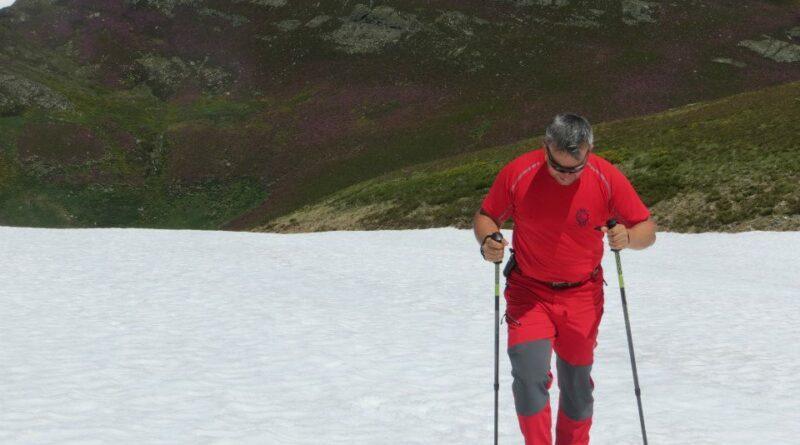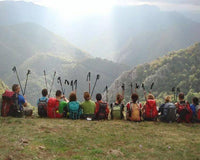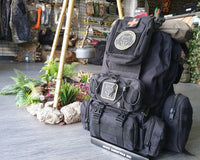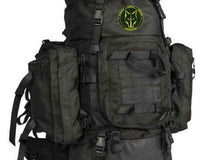All of us who go out into the countryside and mountains, whether we are going on a longer or shorter hike, have carried hiking poles, whether one or two.
I have to admit that I declare myself a die-hard fan of walking sticks (in my case, both of them). I didn't use them for many years, and when I started using them, I never forgot them at home. Even if the walk isn't long, I always carry one on the side of my backpack, since, as we'll see, they're not just for walking.

But why use hiking poles?
- Poles help your arms propel themselves forward and upward. Whether on uphill or flat terrain, they'll increase your cadence and speed by setting a steady, steady pace.
- Reduce the impact on your legs, knees, ankles, and feet, especially when going downhill. In 1999, a study found that trekking poles reduced the compression force on the feet by more than 25%.
- The sticks will be an extension of us, helping us to separate weeds, cobwebs, check the depth of a puddle or the channel of a stream,
- These two extra points of support provide greater traction on slippery or difficult surfaces such as snow, loose rock, or mud; it is always better to have four points of support than just two.
- They help maintain balance on difficult terrain such as river crossings, muddy terrain, or trails obstructed by roots. They also allow us to walk more safely when traveling on steep slopes. Thanks to hiking poles, you can navigate these types of places faster and safer.
- They allow us to use them as extendable poles when setting up a shelter with an awning or tarp, or use them as an arch to make a friction fire.
Parts of a hiking pole.
Handle:
It can come in a variety of sizes and shapes. It's important that the handle fits your hand properly, not the other way around.
Materials can vary widely, including rubber, cork, plastic, and foam, with varying levels of grip and comfort, which should provide a comfortable grip even when it's sweaty or raining. At Northvivor, we tend to avoid trekking poles with soft plastic or foam grips if possible, as plastics can cause problems with sweaty hands or rain, and foams tend to lose their shape. Hard rubber and cork are a better option (in our opinion).

The Dragonera:
This is the strap that accompanies the handle and is passed over the wrist (although many have it for decoration). Above all, it's used to prevent your hiking pole from slipping away, both while walking and in the event of a fall (no one likes having to go searching for their pole at the bottom of a valley).
When walking, it also helps us avoid having to grip the handle too tightly, causing less hand fatigue.
Some people don't like the feeling of having their hand inserted into the strap, but it's highly recommended if you get used to it.

The body of the cane:
Adjustable-length or telescopic poles are the choice of most trekking, mountaineering, and climbing enthusiasts. Why? Basically, because they can be compacted for transport and because they allow the pole's length to be adjusted according to the user's height and the gradient of the terrain. For example, the optimal pole length for ascending is generally shorter than the optimal length for descending.
To adjust the cane to our height, we will hold the cane by the handle and with the arm at a right angle, the distance to the ground, that will be our cane measurement.
Aluminum-bodied poles are a very good option today if you don't want to spend too much and opt for a carbon pole.

Locking mechanisms:
In this case, we do have a clear favorite. And that's the external locking mechanisms.
They are sturdy, adjustable systems, and we can even use them with thick winter gloves. Plus, just by looking at them, we can tell if they are open or closed.
Another system is the threaded one (screwing the lower section inside the upper section) which does not allow you to know at a glance if the cane is locked or not, and the thread can be unscrewed.
Furthermore, the external locking system provides additional security at the joint between the two sections due to the piece it is made of.

Rosettes and cane tips:
The rosettes They are those circular pieces of plastic that go just above the tip of the cane.
They come in various shapes, but are usually circular. Their purpose is to ensure that when walking on snow, mud, or loose terrain, the pole doesn't dig in more than necessary, allowing for normal use. While larger rosettes are better for snow, smaller circular ones are perfect for other types of loose terrain.
The tip , obviously, is the part of the trekking pole that interacts with the ground, usually made of some type of hard metal, harder than rock. It's important to use trekking poles with replaceable tips. Although these days it's difficult to find a pole without interchangeable tips, so they can be easily replaced if they break. Plastic tips are now manufactured to prevent breakage or when walking on asphalt and very hard paths.

And that's all for this brief introduction to hiking poles. We shouldn't view them as simple sticks to lean on, but rather as tools or just another piece of equipment we need to carry. With very little practice, we'll be amazed at the comfort they offer when walking and the freedom from the total weight of our gear.







